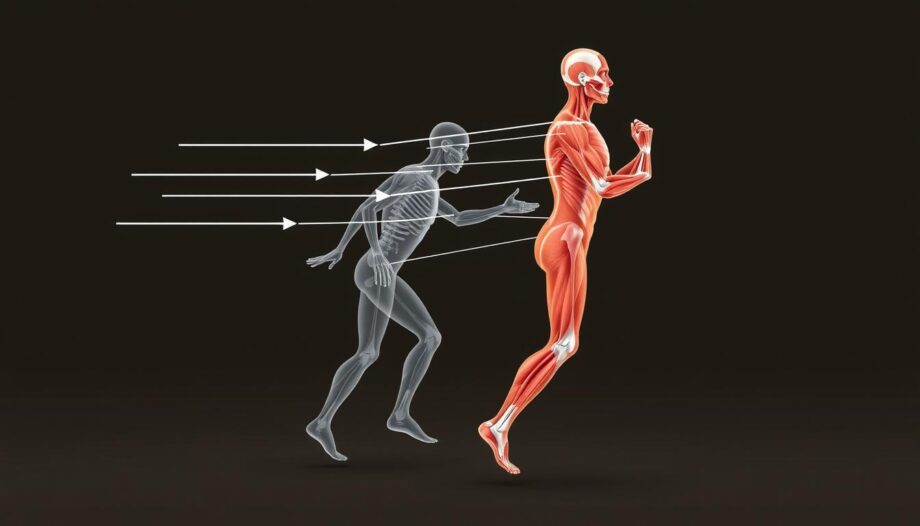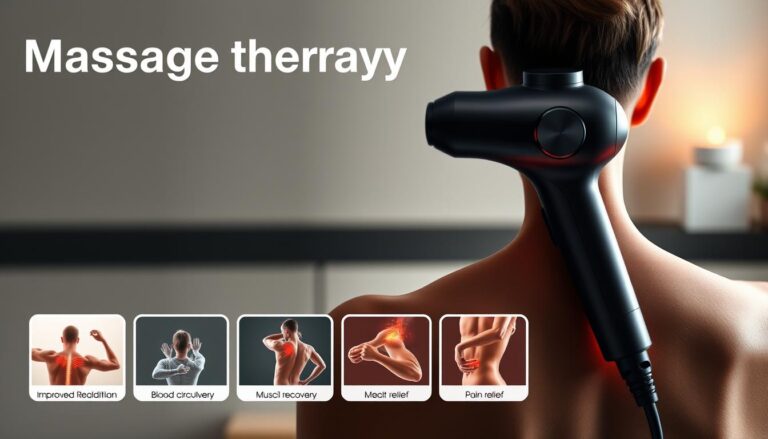The kinetic chain is a key idea in the study of human movement and biomechanics. It’s about the system of joints and muscles working together for motion. It came from Dr. Arthur Steindler’s work. The idea shows how different body parts connect to make functional movements better. Physical therapists, chiropractors, and trainers use it to help prevent injuries, aid in healing, and improve fitness1.
To really get how the kinetic chain works helps fitness experts create customized workout plans. These plans not only boost performance but aid in healing too. Understanding how body systems link together is crucial. It aids in making strategies that promote the best movement2.
What is the Kinetic Chain?
The definition of kinetic chain includes the system of joints and muscles working together. This concept covers both the upper and lower chains. It links important body parts from the spine to our limbs. The upper chain involves the shoulders, arms, and scapulae. Meanwhile, the lower chain contains the pelvis, hips, and legs. These parts are key to our body’s movement.
It’s critical to understand this network. It shows how one area’s action affects another. This insight improves rehab and performance. For example, closed-chain movements improve joint stability and muscle use. These happen when limbs are fixed in place3. Open-chain exercises allow free movement of limbs. They often work on specific muscles.
Knowing how these parts work together is crucial. Problems like scapular dyskinesis can make athletes 43% more likely to have shoulder pain. Understanding the kinetic chain helps professionals improve athletic performance.
Understanding the Components of the Kinetic Chain
The human body works like a complex system. Learning about the kinetic chain can really help improve performance and lower the chance of getting hurt. The upper and lower parts of the kinetic chain are crucial. They work together when we move.
The Upper Kinetic Chain
The upper part involves many joints and muscles. It starts at the spine and includes parts from the shoulders to the fingers. It’s vital for actions like throwing and lifting. Each part plays a key role. For example, shoulders allow a broad range of movements for sports.
If something goes wrong, it might cause bad movement patterns, raising the risk of injury. Understanding how joints work together and training them right is important45.
The Lower Kinetic Chain
The lower part includes areas from the pelvis down to the toes. It’s key for moving our legs, especially in running or jumping. All these joints must work in harmony. Take squatting as an example, the hips and knees work together to keep stable and move well.
Training aims to strengthen these links for better movement. The kinetic chain principle suggests energy flows from one part to the next. This shows how linked our movements are45.
Types of Kinetic Chains
The kinetic chain comes in two main kinds: open and closed kinetic chains. Each kind is key in functional training and focusing on muscles, suiting different workout aims.
Open Kinetic Chain Explained
Open kinetic chain activities let the end part of the limb move freely. This allows for solo movements, like in leg extensions and bicep curls. Here, the hands or feet aren’t fixed, enabling muscles to be worked on singly. These exercises are great for honing in on certain muscle areas, building up strength there. They’re also vital in sports since they often mirror the exact moves needed in various sports. However, doing them wrong can up the chance of hurting joints.
Closed Kinetic Chain Explained
On the flip side, closed kinetic chain activities keep the end limb part in place. Exercises like squats and push-ups work many joints and muscles together, boosting stability. They’re key for real-life movement skills since they copy lots of daily actions. Plus, they help keep joints firm, making sure weak spots don’t drag down your overall ability. Knowing how closed chain moves work is vital. If one joint is struggling, it can throw off the whole exercise
| Type of Kinetic Chain | Examples | Benefits |
|---|---|---|
| Open Kinetic Chain | Leg extensions, bicep curls | Focused muscle work, sport-specific moves |
| Closed Kinetic Chain | Squats, push-ups | More stable joints, everyday movement skills, better sports ability |
Both open and closed kinetic chain exercises play a big part in a balanced workout plan. Mixing them right meets various exercise aims. Knowing about these kinetic chains helps create training plans that focus on move dynamics and body stability. This insight is key for keeping joints working well and avoiding injuries678.
Benefits of the Kinetic Chain
The kinetic chain idea offers many functional benefits that boost our movement skills. It teaches us how our joints and muscles work as one. This approach shifts focus from just working on single muscle groups to looking at entire movement patterns.
Encouraging the use of different body parts together, it helps improve coordination, strength, and efficiency. This is key in sports and everyday actions. Functional training is therefore crucial for better mobility and reducing injury risk.
Functional Movement Patterns
Using the kinetic chain approach shines a light on functional movement. It helps us understand exercise better, shaping effective training plans. Adding both open and closed kinetic chain exercises improves joint stability and muscle activity.
This is especially important for recovery without causing more harm. A coordinated training strategy that focuses on this can help regain function safely.
Joint Stabilisation and Muscle Recruitment
Joint stabilisation and muscle use within the kinetic chain offer notable benefits. Ensuring muscles around joints work well is key for joint health. This reduces injury risks linked to joint problems.
Exercises that adopt kinetic chain ideas help in developing strength evenly across the body. This leads to stronger injury prevention. Recognising the connection between muscles and joints in movements is crucial for top training outcomes91011.
FAQ
What is the kinetic chain, and why is it important?
The kinetic chain includes joints and muscles working together for movement. It is key for creating effective exercise plans and boosting athletic skills. It also helps a lot in recovering from injuries better.
What are the upper and lower kinetic chains?
The upper chain involves the shoulders, elbows, and wrists. On the other hand, the lower chain includes the pelvis, hips, knees, and feet. Both are vital for smooth, coordinated actions that improve how we move and perform.
How do open and closed kinetic chain exercises differ?
Open kinetic chain exercises let the arms or legs move freely, targeting specific muscles. For example, leg extensions and bicep curls. Meanwhile, closed chain exercises keep the limb end fixed, like squats or push-ups, which stabilises joints and works many muscles at once.
What are the benefits of focusing on joint stabilisation and muscle recruitment in training?
Training with a focus on stabilising joints and activating muscles evenly builds better strength. It keeps joints healthy and cuts down on getting hurt. It’s especially crucial for people getting back in shape after injuries, helping them gain back their functionality safely.
How does understanding the kinetic chain contribute to better functional movement patterns?
Knowing how body parts connect and function together allows for designing better training plans. These plans improve coordination, power, and movement efficiency. They’re great for athletes and also for everyday life, making moving easier and reducing chances of injury.





